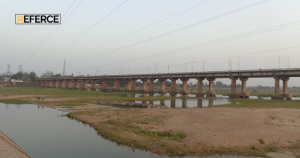Top 10 Longest Rivers In India
The rivers have been referred to as the lifelines of India since they supply drinking water and irrigation water, highly regarded as holy to the various cultures of this country. Below is an article on the top 10 longest rivers in India. From the majestic Ganges to the great Godavari, each river holds tales of importance to the land and its people. Follow this unique path of the rivers, from one source to another, learning how long each one is, where it comes from, and how far its waters flow.
Top 10 Longest Rivers in India
| River | Length in India (km) | Total Length (km) |
| Ganga | 2525 | 2525 |
| Godavari | 1464 | 1465 |
| Krishna | 1400 | 1400 |
| Yamuna | 1376 | 1376 |
| Narmada | 1312 | 1312 |
| Indus | 1114 | 3180 |
| Brahmaputra | 916 | 2900 |
| Mahanadi | 890 | 890 |
| Kaveri | 800 | 800 |
| Tapti | 724 | 724 |
1. Ganga River (2525 Km)

Ganges River one of the longest rivers found in India has been largely revered as an iconic cultural ecology and economic resource necessity. The river originates from the Himalayas, flowing for a length of about 2,525 km, the longest river in India to its confluence with the Bay of Bengal. Its course, therefore, covers a huge area, therefore supporting the livelihood of millions through agriculture, industry, and daily support of water needs. The river Ganga is also held very sacred by many; it has spiritual value and centers the heart of religious practices and beliefs throughout the country.
- Beginning: The Ganges originated from the Gangotri Glacier, located in the Indian state of Uttarakhand. This glacier is situated amidst the Himalayan Range.
- supportive: Its major tributaries include the Purna, Pranhita, Indravati, Manjira, and Sabari rivers. These contribute significantly to the river’s volume and the fertility of its basin.
- Location: Uttarakhand
2. Godavari River (1465 Km)

The Godavari River represents the major one among the country’s longest rivers. Its source is found from the Western Ghats in Maharashtra, flowing across the very heart of Central India, and its downstream spews out into the Bay of Bengal. Godavari flows over an expanse of approximately 1465 km and bears extreme importance for irrigation. It gives firm support to a large section of agriculture across many Indian states. However, above and beyond the economic value, this river has deep cultural and spiritual value, as its banks serve for the venues of myriad religious festivals and sacred rituals.
- Beginning: It originates near Trimbak in the Western Ghats of Maharashtra, India. The origin site has the famous Trimbakeshwar Shiva Temple.
- supportive: Major tributaries, with the area they cover, include the Purna, Pranhita, Indravati, Manjira, and Sabari rivers, with many volumes that contribute much to the river.
- Location: Andhra Pradesh 533249
Also Read: Top 10 Best Places To Visit Delhi
3.Krishna River (1400 Km)

The Krishna River is the longest concerning distance, i.e., 1400 km. The Krishna River is of enormous importance for farming. It helps many farms in these states get the water they need to grow crops. This river has not only served the purpose of farming but also to fish out of it so that people living in houses can have it as a source of fish for supplying and supplying water. On the other side, the Krishna River has been facing some problems, including pollution and increased water demand during dry times. But it remains a vital source of life and culture in southern India.
- Beginning: This shows that it is at an elevation in the Western Ghats at Mahabaleshwar that the Krishna River originates.
- Supportive: It has important tributaries, such as the Tungabhadra, Bhima, Mallaprabha, and Koyna rivers, which bring the river volume and fertilize the basin.
- Location: Maharashtra
4.Yamuna River (1376 Km)

- Beginning: The Yamuna after that emerges from the Yamunotri Glacier in the Higher Himalayas.
- supportive: Among its chief tributaries are Chambal, Sindh, Betwa, and Ken. Much, therefore, of the volume of the basin and its fertility is dependent on this point
- Location: Himachal Pradesh
5.Narmada River (1312 Km)

- Beginning: Originates from the Amarkantak Plateau of Madhya Pradesh.
- supportive: Key tributaries include the Burhner, the Banjar, the Shar, the Shakkar, the Tawa, and the Kaveri, which help nourish the river basin.
- Location: Madhya Pradesh
Also Read: Navigating the Intersection of Education and Morality: A Parent’s Dilemma
6.Indus River (3180 Km)

The 1114 km-long Indus River River originates in the southwestern Tibet Autonomous Region of China near Lake mapam. It originates from the Tibetan Plateau near Lake Mansarovar. It flows about 3,180 kilometers in length, which denotes it as one of the major rivers in Asia. The River Indus is primarily within Pakistan, yet it is of much more cultural and historical importance to the people of India. This river has its source lying far to the north.
- Beginning: The source of the Indus River, near Lake Mansarovar, is on the Tibetan Plateau. From the Aksai Chin area of Ladakh, it falls into India.
- supportive: Supportive: All major river tributaries come from rivers Zanskar, Sutlej, Beas, Ravi, Chenab, and Jhelum. In essence, they all contribute well over half of the river flow and, in fact, more than half of the agricultural viability.
- Location: Jammu and Kashmir
7.Brahmaputra River (2900 km)

Brahmaputra River is amongst the longest rivers in India and originates from Angsi Glacier in Tibet under the name Yarlung Tsangpo.
It flows 2,900 km from its sources in Tibet to finally pour out into the Bay of Bengal. The rivers and their tributaries in between, from hills to scenic areas of Arunachal Pradesh and fertile plains of Assam, hold the crucially poised ecological and cultural heritage of the region.
- Beginning: Originating from the Himalayan glaciers in Tibet and called the Yarlung Tsangpo, the river enters India in the State of Arunachal Pradesh; after that, it is also called the Siang or Dihang.
- Supportive: Most tributaries flowing into the river support and contribute their flow and fertility to the basin; these comprise the Dibang, Lohit, and Subansiri.
- Location: Kailash ranges of Himalayas
8.Mahanadi River (890 Km)

Mahanadi River is an 800-mile important eastward-flowing river in Central India, mainly over the states of Chattisgarh and Odisha, finally discharging into the Bay of Bengal. This river beholds immense roles in the agriculture, livelihood, and culture of the regions.
- Beginning: The Mahanadi originates from the Sihawa Mountain in Chhattisgarh.
- supportive: Key tributaries include the Seonath, the Jonk, the Hasdeo, the Mand, the Ib, and the Ong. These contribute to its flow and enhance the agricultural potential of its basin.
- Location: Raipur district of Chhatisgarh
Also Read: Best Places To Visit In Mumbai
9.Kaveri River (800 Km)

The Kaveri River is considered longest rivers of India, and she is said to take birth from the tranquil Talakaveri of the Western Ghats. Down it winds along, coursing through the southern heartlands of Karnataka and Tamil Nadu, the Kaveri confers life not only to the land but also imparts fullness to the lives of millions dependent on its waters. The Kaveri River was a very essential symbol of life and prosperity with regard to agriculture, energy, and culture. Its waters are a source of both sustenance and strife due to the intense dependency and disputes over its use. River Kaveri the river with the blessings of plenty, at the same time, is considered as the river of conflict.
- Beginning:The river Kaveri begins from the Western Ghats at Talakaveri in Karnataka.
- supportive:upportive: Some of the major tributaries that offer supportive nature include Shimsha, Hemavati, Arkavati, and Bhavani. Most of the rivers are used for sustenance; they carry the load of the Kaveri and enrich it for irrigation and ecology importance..
- Location: Talakaveri in the Brahmagiri range of the Western Ghats in the Kodagu district of Karnataka.
10.Tapti River (724 Km)

Springing forth from the Satpura Range among the best of lush greens the Tapti River burrows a journey in the westward direction from the heart of the country to finally meet the Arabian Sea in Gujarat. The river not only supports the lands over which it runs but also has pride of place in the hearts of the people along its banks. The River Tapti is great and has great cultural significance. It serves all purposes, namely lifeline to agriculture, industry, and local economies, sustaining the natural ecosystem and human communities in Madhya Pradesh, Maharashtra, and Gujarat.
- Beginning: The Tapti originates in the eastern Satpura Range of Madhya Pradesh.
- supportive:. Significant tributaries include the Purna, Girna, Panzara, Waghur, and Bori rivers. These contribute to the Tapti’s flow and are essential for the regions they traverse.
- Location: Satpura ranges of the Betul district of Madhya Pradesh.
conclusion:
All these rivers, right from the Ganges to the Godavari, Krishna, Yamuna, Narmada, and Brahmaputra, joined in by the Mahanadi, Kaveri, and Tapti, to name a few, have been very human in their participation in evolving the geomorphology of the region. These rivers count among the first 10 longest rivers of India and the world, therefore being a very important resource not only for its provision for essential resources like water for agriculture and daily use but also a resource of deep spiritual significance for millions of people.




